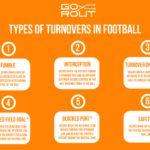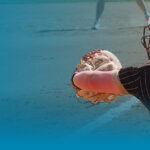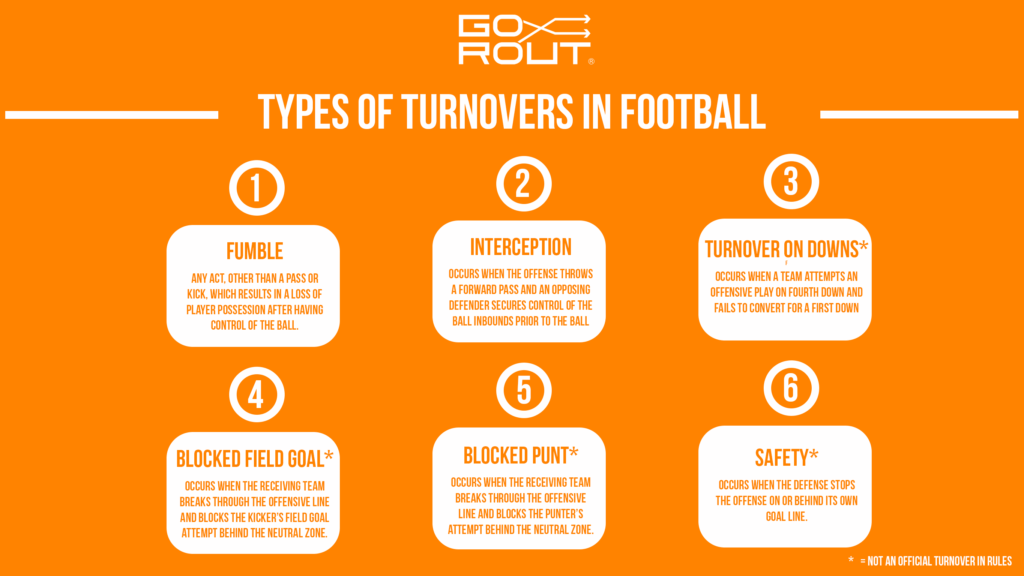Softball Hitting: Fundamentals, Technique, and Strategies
Reading Time: 10 minutes
Reading Time: 10 minutes
Stepping up to the plate with confidence sets the stage for success in softball. A team’s performance often hinges on its ability to make solid contact and drive the ball.
Whether coaching a youth squad or leading a competitive team, improving your players’ hitting skills is paramount.
In this post, we’ll cover 16 essential tips to boost your team’s performance at the plate. From mastering the fundamentals of a powerful swing to fine-tuning mental strategies, these actionable tips will help your hitters find their sweet spot and start crushing the ball.
Understanding the Fundamentals of Softball Hitting

One of the most important aspects of softball coaching is understanding the fundamentals of softball hitting. Players can lose power at the plate without proper hitting tips and weight distribution.
Essential fundamentals for developing a consistent and powerful hitting technique include the stance, grip, and swing mechanics.
The stance: Building a solid foundation

A proper softball stance is the foundation for effective hitting. Players should stand with their front and back feet shoulder-width apart, knees slightly bent, and the weight evenly distributed.
This fully extended, balanced position gives hitters a strong base for generating power and maintaining stability throughout the swing.
A player can start with most of their weight on their back foot, leg, and hip and finish by distributing it to the front foot—the foot closer to the pitcher.
Keeping the upper body relaxed and the head still helps maintain focus and improves the chances of making solid contact with the pitch.
The grip: Holding the bat correctly
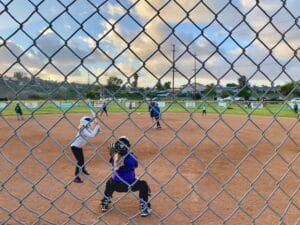
Holding the bat correctly creates control and power. Players should grip the bat lightly with their fingers, not their palms, and keep their hands close together.
Hitters should step into the batter’s box with their knuckles in a straight line for a smooth and natural swing. This grip allows for better bat control and quicker wrist action during a good swing. The key is to get the hands through the zone with a level barrel for positive, powerful contact.
The swing: Mechanics that drive success

Image source: Unsplash
A good swing involves a smooth, level swing path that stays in the strike zone longer for better chances of making solid contact. Good rotation of the hips and a high, smooth follow-through contribute to a powerful and controlled swing. Keep the head still throughout the swing for consistent mechanics.
Advanced Techniques for Power Hitting
Mastering power hitting in softball requires advanced techniques that focus on specific aspects of the hitter’s body and swing to increase power, bat speed, and efficiency.
The role of the hips in generating power
Proper hip rotation starts by turning the hips toward the ball as the swing begins. It transfers energy from the lower body to the upper body to maximize the force applied to the ball on a powerful swing.
Strong, explosive hip rotation generates more power potential and makes swinging impactful. The hips must be timed with the rest of the swing mechanics for more power.
Wrist snap: Increasing bat speed and power
A quick and controlled snap of the wrists increases bat speed as the bat crosses home plate. This rapid wrist movement creates more powerful contact. Practicing the wrist snap technique helps hitters develop quicker hands and better barrel control for improved performance at the plate.
Drills to Improve Softball Hitting Skills
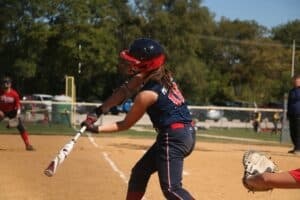
Image source: Unsplash
Softball hitting drills help players refine their technique, improve their physical conditioning and build mental focus. Young hitters use drills to address weaknesses, reinforce strengths and develop the muscle memory needed for effective softball hitting.
Developing hand-eye coordination
Improving hand-eye coordination is essential for an effective softball batter. Hitting drills help players track the ball from the pitcher’s hand to the contact point, leading to better timing and accuracy.
The best softball hitting drills to improve hand-eye coordination include:
- Tee work
- Soft toss
- Side toss drill
Building strength and flexibility
Softball hitting drills can also build strength and flexibility. Strength and flexibility directly impact a player’s ability to hit the ball, generate power, maintain control and reduce the risk of injury.
Weight training exercises such as squats, lunges and deadlifts help develop lower body strength. Exercises like bench presses, rows, front shoulder presses, and back shoulder overhead presses build upper body power.
Core exercises, including planks and Russian twists, enhance stability. Incorporating flexibility exercises like dynamic stretching and yoga helps maintain muscle elasticity and prevent injuries.
Circuit training for softball hitters
Circuit training is important for a softball player because it provides an engaging way to improve fitness, develop hitting skills, build strength and power, enhance flexibility and prevent injuries.
A well-rounded circuit includes stations focusing on these aspects of hitting and physical conditioning:
- Tee work
- Resistance band swings
- Medicine ball throws
- Agility drills
- Strength training
By rotating through these stations, hitters can develop the skills and physical attributes necessary for successful power-hitting.
Mental Strategies for Better At-Bats
Mastering the mental aspects of batting is one of the hitting tips that helps a softball hitter maintain focus, manage pressure and make better decisions during at-bats.
The importance of visualization and routine
Visualization and routine are powerful mental strategies that improve a player’s performance at the plate and relieve stress and anxiety.
Visualization involves mentally rehearsing successful at-bats to build confidence and prepare for unpredictable game situations. Softball players picture themselves making good contact, hitting the ball hard and reacting well to pitches with a positive mindset.
Establishing a pre-at-bat routine helps players manage their nerves, maintain concentration, and reach the right mental state before stepping up to the plate. This routine might include adjusting batting gloves, taking deep breaths or visualizing the upcoming pitch.
Adjusting to different pitchers and scenarios
Every pitcher has unique strengths, weaknesses, and pitching styles. Recognizing and adapting to these differences can give hitters an advantage at bat.
Hitters must remain flexible and make real-time adjustments based on their observations. This might involve changing their closed stance, timing or approach depending on the type of pitch. Facing a fast pitcher requires starting the swing earlier, while a pitcher with a lot of movement needs a more patient, selective approach.
Adjusting to different game scenarios, such as hitting with runners in scoring position or protecting the plate with two strikes, requires strategic thinking and situational awareness.
Analyzing and Using Player Data

Using sports coaching technology, such as video analysis, performance metrics, and wearable technology, to analyze players leads to more precise adjustments, informed decision-making and superior performance on the softball field.
Using video analysis to improve technique
Video analysis software records at-bats and breaks down the footage so that coaches and hitters can identify areas for improvement. It thoroughly examines a hitter’s stance, grip, position, swing mechanics, and follow-through.
Coaches can highlight key moments, such as the point of contact with the ball, hip rotation, bat speed. Hitters can use different angles to understand their strengths and weaknesses and make precise technique adjustments.
Tracking performance metrics
Tracking batting average, on-base percentage, and slugging percentage measures progress and identifies areas for improvement for hitters. Exit velocity, launch angle and swing path efficiency metrics provide deeper insights into a player’s hitting capabilities.
Wearable technology in sports, such as smartwatches, fitness bands and specialized sensors, gathers real-time data on heart rate, activity, body mechanics and GPS field location.
Coaches monitor these key performance indicators to assess the effectiveness of training programs and make data-driven decisions. If a player’s exit velocity is low, emphasize strength and conditioning exercises to increase power.
You can adjust swing mechanics or pitch selection strategies if a player struggles with a high strikeout rate.
Improving team performance with GoRout Diamond

Source: GoRout
GoRout Diamond is an electronic pitch-calling system designed to improve communication between coaches in the dugout and players on the field. It facilitates coaches’ transmission of pitch calls, defensive strategies, and offensive plays to players in real-time.
GoRout Diamond replaces traditional hand signals to improve the team’s performance and efficiency during practices and games.
The GoRout equipment operates in a few simple steps.
With just a few taps, coaches create pitch calls, set defensive shifts, and design offensive plays using the coaches’ app. They then send these pitch calls to the players on the field.
Using wristbands, players can easily select their position, quickly receive position-specific messages, and play calls for efficient gameplan execution. They receive the call, execute the play, and win the game!
The GoRout player device is ready for immediate use without setting up, pairing, or programming. The wristbands are not reliant on Wi-Fi and are fully encrypted for use in games and practices.
How GoRout Diamond Boosts Team Performance
GoRout Diamond improves team performance through its customizable coaching technology. Prompt communications leads to quicker adjustments and more coordinated strategies tailored to individual player strengths and game situations.
With GoRout Diamond, coaches can create personalized strategies by inputting individual pitch repertoires, defensive shifts, opponent lineups, and position-specific messages. For batters, the ability to have plays sent directly to their device eliminates the need to memorize signals. GoRout Diamond ensures that your team never misses another sign at the plate or on the bases!
GoRout Diamond boosts performance and teamwork, enhances decision-making, and improves softball drills for better softball hitting and reduced miscommunication during games.
Check out these GoRout testimonials to learn how this technology has helped thousands of teams improve communication and have a more successful season.
Benefits of GoRout Diamond in softball coaching
GoRout’s coach-to-player communication system improves softball hitting and simplifies pitch calling with these game-changing benefits for coaches and players:
- Our weather-resistant devices withstand all weather conditions, including rain, extreme heat, humidity and snow. Each has light and dark screen modes for increased visibility during sunny days, night games and overcast conditions.
- GoRout softball devices are one of the few NCAA-compliant technologies for in-game use at the college level.
- GoRout devices are secure and come with a four-way privacy screen. Pitch calls are 100% encrypted, allowing teams to secretly send and receive instructions.
- Our advanced tech app and devices are developed and approved by fellow softball coaches to ensure a seamless communication experience.
- GoRout Diamond has a comprehensive warranty covering breakage and defects, ensuring reliability and confidence in every device.
Equipment Considerations for Optimal Hitting

Choosing the right equipment for each softball player’s needs can amplify their hitting performance. The right bat, gloves, and accessories help players swing confidently and comfortably.
Selecting the right bat affects swing speed, control and power. Key factors to consider when choosing a bat include:
- Length and weight: The bat should be the right length and weight for the player’s size, strength and hitting style. A bat that is too heavy can slow down the swing, while one that is too light won’t provide enough power to hit for power.
- Material: Bats are made from wood, composite or aluminum. Aluminum bats are durable and provide good power. Composite ones offer a larger sweet spot and decreased vibration. Wood bats are useful for softball training.
- Balance: End-loaded bats provide more power for strong hitters. Balanced bats offer increased control and are easier to swing for contact hitters.
- Grip and comfort: The bat must have a comfortable grip to prevent slipping and reduce vibration in contact with the ball.
Gloves and batting tape provide comfort, grip and protection.
Quality batting gloves improve grip and reduce friction between the hands and the bat to prevent blisters and improve control. They also offer a layer of padding that can absorb the impact of contact.
Applying tape to the bat handle can strengthen grip and control. It allows players to customize the thickness and texture of the handle.
In-Game Strategies to Maximize Hitting Success
In-game strategies adapt players to different game situations to make smart decisions that benefit the team. These strategies lead to more scoring opportunities and greater chances of winning in softball.
Reading the pitcher and anticipating pitches
Effectively reading the pitcher and anticipating pitches begins with studying the pitcher’s tendencies before the game. Analyze the pitcher’s most frequent pitches, sequences and preferred pitches in different counts to predict what might be coming next.
Subtle cues during the game, such as a change in grip or arm angle, indicate the pitch about to be thrown. A higher release point might signal a fastball, while a lower one could suggest a curveball.
Maintain count awareness to understand a pitcher’s typical behavior. For example, in a 0-2 count, pitchers might try to get the hitter to chase, where in a 3-0 count, they are more likely to throw a strike.
Situational hitting: Making wise decisions
Mastering situational hitting in softball involves making strategic decisions based on the game context—hitting to move a runner over, drive in a run from third or avoid a double play.
Effective situational hitters adjust their approach depending on the count, the type of pitcher they are facing and the defensive setup. With a runner on third and less than two outs, a hitter might focus on hitting a fly ball deep enough to allow the runner to tag up and score.
Train for situational hitting with drills that simulate game scenarios, so hitters stay calm and focused during actual games.
Regular Assessment and Goal Setting
Setting achievable hitting goals gives teams a reason for continuous improvement and motivation.
Effective hitting goals should be specific, measurable, attainable, relevant and time-bound. For example, a hitter might set a goal to improve their batting average by a percentage over the next month or to reduce strikeouts by focusing on making consistent contact.
Short-term goals, such as focusing on timing or increasing on-base percentage in the next game, provide immediate targets. Long-term goals like achieving several home runs by the end of the season offer a broader focus.
Regular assessments track hitting progress. They involve analyzing performance data such as batting average, on-base percentage, slugging percentage and strikeout rates.
Video analysis can also be used to review swing mechanics and identify areas for improvement. Coaches and players should hold periodic review sessions to discuss progress, celebrate achievements, and address challenges.
Conclusion
Improving a team’s softball hitting performance involves mastering fundamental techniques, employing advanced power-hitting strategies and integrating effective softball hitting drills.
Regular assessment and goal-setting ensure continuous improvement, while in-game strategies and situational hitting maximize offensive opportunities.
Advanced tools like GoRout Diamond can streamline communication and hitting in softball.
Get a quote to give your team a competitive edge through real-time, tailored pitch calls and a no-hassle strategy this season.
FAQs about Softball Hitting
How do you become a good softball hitter?
To become a good softball hitter, you must improve your hand-eye coordination, master your swing mechanics, and practice regularly to develop your timing and power. Studying pitchers and understanding different pitch types can also help improve your hitting performance.
Is it called batting or hitting in softball?
Batting and hitting are commonly used terms in softball that are often interchangeable. Batting typically refers to the act of a softball player taking their turn at bat, while hitting emphasizes the action of the bat swinging and making contact with the ball.
How to hit harder in softball?
More batting power comes from strong hips, glutes, core, upper body, front leg and back leg strength. Train the front leg, back hip, leg and glutes by regularly throwing medicine balls and weight lifting with proper form for harder softball hitting.

